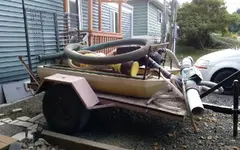winners58
Bronze Member
someone should rescue this Schmidt Gold Trap bazooka
put it in a gold mining museum or just to study the engineering

put it in a gold mining museum or just to study the engineering



Yup, that's the 2nd generation Gould Engineering Gold Dredge design - designed by Reggie Gould. It was last being produced by his son but that's still ancient history.
So within vortex bazooka it looks like the catch chamber is closed off? Is this the case and if it is how does it not overload with heavies? In the pic below it doesnt appear to have an outlet in the catch area.Yea, towards the end, his builds went down hill, but it always was a solid design that worked great. We all talked mining for hours every day down at Pioneer Mining back in the 90's, pretty much a "Good Ol boys club". Good times, great memories. Frank and I are the last 2 living from the old group... Reggie was good people!
I looked into the electric dredge from an engineering standpoint. Your only option for the pump is a powerful brushless electric motor with 3-phase drive, that is mounted to a classic water pump (Keene, Proline, Dahlke) (you need to have a custom shaft machined for the electric motor, take it apart and swap the shaft). However, the implementation has countless issues and challenges. Right now, the only simple method is to take the new Honda eGX electric motor which is similar in form factor to the GX120, and bolt an existing pump to it. However, the eGX engine does not come with a 5/8" threaded shaft needed for the Keene and Proline pumps. This means the only pump that works with it are the Dahlke pumps that accept the 3/4" keyed shaft-- however Dahlke has gone silent, so very hard to get those pumps. Still, theoretically the eGX engine with the Dahlke DP150, mounted on top of the dredge, would run silently, however, the engine weighs double the amount of the gas engine equivalent and the battery life is only 30 minutes, and if you add an air compressor via belt drive, it will be almost as noisy as a gas engine, defeating the entire purpose. To make the dredge fully silent, you'd need the electric motor driving the pump, then you'd have to use a scuba tank. With the battery lasting 30 minutes on the pump, and the scuba tanking lasting you about 1 hour, you might be able to do a very brief sample hole but no chance for any production volumes. If you try to take a classic air compressor and put it underwater in a chamber with a snorkel, not only does it still produce noise on the surface but the noise underwater is so loud it can cause hearing damage. As many people have already stated, it is remarkably difficult to make a dredge that is better than the ones ready-made, even though at first glance it looks like it would be easy. In reality, taking an existing stock Keene or Proline dredge, the only modifications which are practical, are weight reducing mods like rebuilding the frame out of titanium or 7075 aluminum, and switching to lighter suction hose. Titanium does not come stock in square tubing, meaning you need custom extrusions which are not cost effective for a single dredge. If you wanted to go REALLY exotic, there is an alloy called AlBeMet-162 which is aluminum and beryllium, it is more rigid than steel and lighter than aluminum, but the cost is ridiculous and it must be painted because it is toxic to touch.So within vortex bazooka it looks like the catch chamber is closed off? Is this the case and if it is how does it not overload with heavies? In the pic below it doesnt appear to have an outlet in the catch area.
I’m designing my interpretation in autocad and I’m trying to figure out if the catch area needs an outlet for the captured black sands. With the vortex throwing the heavies to the outside a spiralized slit would allow the heavies to fall into the catch area while the light material gets blown down the center of the water column and out of the dredge. But it seems that the heavies would build up.
Still have a lot of design work to do especially since I plan on trying to make it completely electric which means designing my own pumps since none out there seem to be up to par with what is needed.
Oh well more to come. May start a new thread once I get some of the parts printed.


 might be hard to find !
might be hard to find !